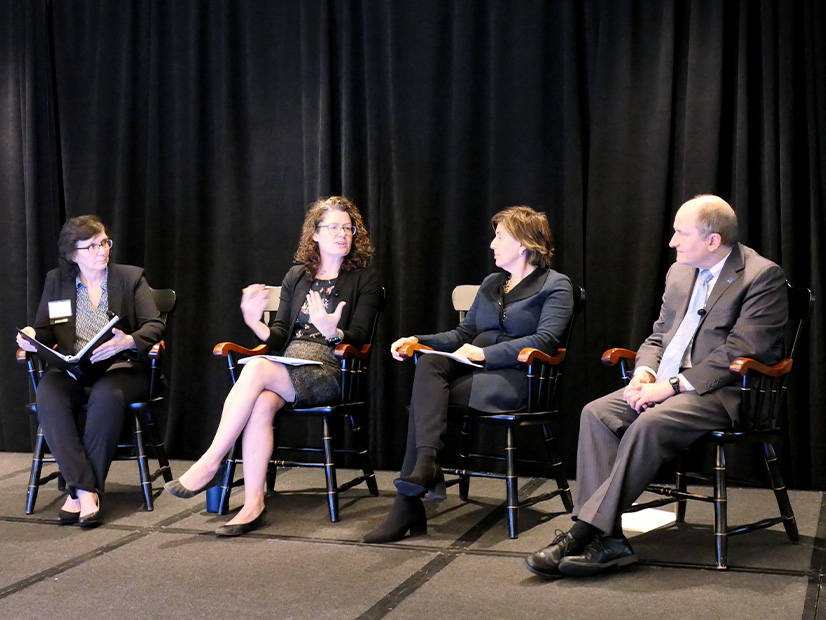
New England policymakers and stakeholders must not overlook the need for electric affordability in the energy transition, officials from Massachusetts, Rhode Island and Connecticut told attendees of the New England Power Generators Association’s fifth annual New England Energy Summit.
BOSTON — New England policymakers and stakeholders must not overlook the need for electric affordability in the energy transition, officials from Massachusetts, Rhode Island and Connecticut told attendees of the New England Power Generators Association’s fifth annual New England Energy Summit on Dec. 6.
Rhode Island Public Utilities Commission Chair Ron Gerwatowski compared juggling the priorities of decarbonization, reliability and affordability to “adopting a coyote, a wolf and a bunny rabbit, putting them in the same corral, and asking how you can get them to get along without harming each other.”
“The coyote and wolf might find a way to coexist, but that bunny rabbit, I don’t know about it,” Gerwatowski told attendees.
The bunny rabbit, in Gerwatowski’s analogy, is affordability. With decarbonization and reliability considered nonnegotiable in the region, affordability is being overlooked, he said.
“When we add up the combination of rising costs from distribution, transmission, regional markets and renewable procurements, electricity rates are driven upward, and affordability gets severely strained,” he explained.
To prevent rates from skyrocketing, Gerwatowski said that policymakers should consider impacts on ratepayers when weighing different decarbonization strategies, and potentially avoid funding transportation and heating decarbonization initiatives through electric rates.
Additionally, states should consider providing stronger price signals and demand response incentives for consumers to reduce their electricity consumption during times of peak loads to limit the overall demand on the system and bring down prices, he said.
“I’m not suggesting that we slow down our pursuit of a carbon-free future,” Gerwatowski said. “What I’m saying is that it’s not too late to adjust the way we plan for our future.”
Rebecca Tepper, secretary of Massachusetts’ Executive Office of Energy and Environmental Affairs, agreed with Gerwatowski’s concerns about affordability and noted that the Massachusetts Department of Public Utilities is planning to open a docket focused on rate affordability.
“Addressing things on the demand side is extremely important,” Tepper said, pointing to the results of ISO-NE’s 2050 Transmission Study, which found that reducing the 2050 winter peak load from the projected 57 GW to 51 GW would save the region roughly $8 billion. (See ISO-NE Prices Transmission Upgrades Needed by 2050: up to $26B.) Tepper floated the idea of a “6-GW Earthshot challenge.”
Tepper added that the region should “think as creatively as we do about generation with demand response. We’ve all started thinking about energy efficiency as our first fuel; reducing demand needs to be our second fuel.”
Katie Dykes, commissioner of Connecticut’s Department of Energy and Environmental Protection, said collaboration between Northeastern states around clean energy generation and infrastructure will be “the key to addressing affordability challenges.”
Dykes added that collaboration can both enable states to unlock lower prices through larger contracts and help states share the costs of projects that provide regionwide reliability benefits.
“We’re benefiting in Connecticut from the investments that Massachusetts is making in transmission to import hydropower,” Dykes said. “The entire region is freeriding on the support that Connecticut ratepayers are providing to prevent the Millstone nuclear facility from shutting down.”
Building Local Support
The officials and other industry speakers also stressed the importance of building local support for clean energy projects by communicating the climate benefits and providing tangible local incentives for communities to host infrastructure.
“We need to get communities excited about the energy infrastructure that’s in their towns,” Tepper said.
The “fundamental question,” said Mike Cuzzi of Cornerstone Government Affairs, is whether “the social and political will is there to build these things.”
Cuzzi added that building community partnerships early in the development process and speaking to the self interest of local communities are essential aspects of building support for projects.
“Listening to the people, early, upfront and understanding where you’re going to have problems … all those pieces are very important,” Cuzzi said. “Even that may not lead to success, but you’re at least going to win some degree of the public relations war.”
Gerwatowski called upon environmental activists and organizations that advocate for clean energy legislation to support clean energy infrastructure in regulatory proceedings and help communicate the climate benefits of electric infrastructure to local communities.
“They’re noticeably absent in these proceedings,” Gerwatowski said. “Why aren’t you coming out in droves like when it’s time to pass a bill?”

